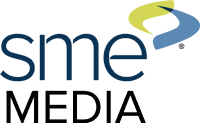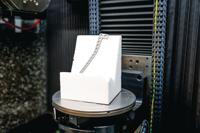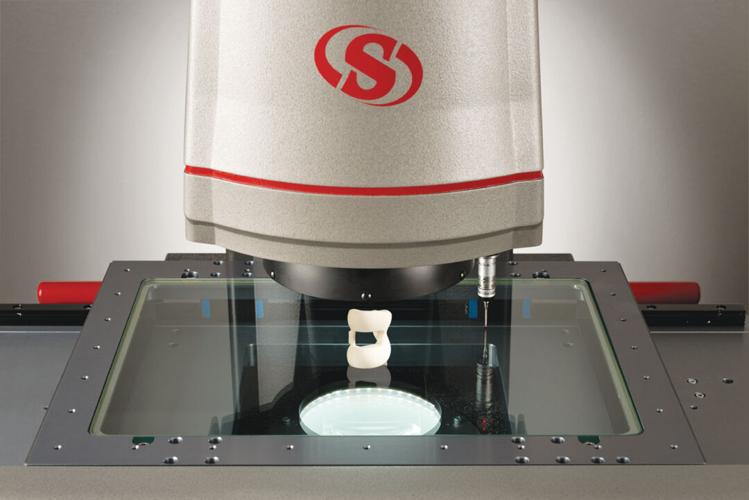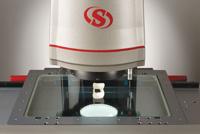If asked to define the term “medical metrology” and describe what differentiates it from other forms of industrial measurement, many machinists might just shrug their shoulders and say, “I don’t know—parts are parts,” and go back to work.

Hexagon’s HP-L-10.10 laser-scanning sensor checking a knee implant.
There’s certainly merit to this position. After all, when cutting a chunk of titanium, it doesn’t much matter to the machinist whether the finished workpiece will end up in an F-35 fighter jet or Grandpa Joe’s hip. The people responsible for meeting the strict regulatory requirements imposed on medical device manufacturers know better, however. They know that every component—whether it’s a tiny bone screw or a hugely complex magnetic resonance imaging (MRI) system—will impact the care and possibly even the life of a fellow human being, and must be treated accordingly.
Proper measurement of medical parts is serious business.
Fast and Furious
Many of these parts are produced in very high volumes. Consider the bone screws example: According to the National Center for Biotechnology Information, billions of screws are inserted by surgeons each year.
Bone screws and countless other medical components must undergo 100% inspection, quantities notwithstanding. “As you can imagine, speed is critical in these applications,” says Eduardo Bolivar, product sales specialist at Marposs Corp., Auburn Hills, Mich.
He points to Marposs’ OptoFlash XS, the smallest member of a family of automated optical inspection (AOI) systems, some of which can execute up to “100 static measurements in just two seconds.” With this are a variety of laser-based measurement systems, among them a number of devices used to perform rapid, 100% inspection of small wires and cables, needles, molded plastic containers and much more.
“For the very high-volume components just mentioned, these systems are often integrated directly into the production line, while others are better suited for more traditional, offline inspection,” Bolivar says. “In either case, lasers are an ideal measuring tool due to their speed and great accuracy. They’re also quite easy to reconfigure for various parts—all that’s needed is a small change to the program, perhaps a different workholding fixture, and you’re up and running.”
Greg Maisch, the engineering manager for the The L.S. Starrett Co.’s Starrett Metrology Division in Laguna Hills, Calif., agrees with Bolivar’s assessment that the flexibility and ease of use of lasers and optical systems make them popular tools—especially the “optical” part. Starrett Metrology provides support and product development of optical comparators, video inspection and vision systems—the multisensor AVX550 among them.
Light It Up
Maisch also seconds the need for 100% inspection, answering at least one important question: What makes medical metrology different?

The OptoFlash XS60 is part of the Marposs family of 2D optical measuring systems, capable of measuring a variety of small fasteners, screws and medical implants, returning a graphical report within seconds.
“It’s not like typical inspection where you’re periodically checking parts based on a sampling plan,” he explains, adding that medical device manufacturers and their component suppliers often need to inspect every single part and keep a record of the inspection. “As a result, your measurement device should be tied very tightly to the rest of the quality system.”
This integration is critical, he stresses, but so is cleanliness. Vision systems—and any non-contact measurement technology—demand that parts are completely free of oil and other contaminants. And for components that might end up inside the human body or see use in a surgical environment, cleanliness is a prerequisite.
Meeting part geometry specifications can be even more challenging. Orthopedic devices such as knee and hip implants are relatively non-prismatic, Maisch explains, meaning they contain complex curves and few right angles.
“Knees in particular can be tricky to measure, and we will need to rotate them to the correct angle in order to pick up the curvature,” he says. “With that are very smooth, highly reflective surfaces, which on a vision machine means having the correct lighting tools. Factors like these are why medical manufacturers typically ask for capability studies before investing in advanced metrology equipment.”
Taking It on the Road
Given all this talk about non-contact metrology systems, it should be noted that contact-based measurement is equally important to the medical community. “My job is to educate potential customers throughout North America about portable measuring arms, a solution that is typically used when the object is either too large, too remote or too immobile to check on a coordinate measuring machine (CMM),” explains Brian Winters, product sales manager at Hexagon’s Manufacturing Intelligence division, North Kingstown, R.I.
When asked what medical components fall into these categories, Winters response is surprising. “Let’s say you have someone who’s injured and shouldn’t be moved. A portable arm lets you go to them, quickly measure the affected area, and then offload the resulting data to produce a mold or 3D-printed prostheses, essentially reverse-engineering the patient.”
Hexagon’s Absolute Arm is not limited to people. It’s also used to measure operating room theater equipment such as lights, beds, surgical tools and sterilizing equipment to validate the motion of medical robots; and it can qualify the assembly of machines for hematology, hemostasis and clinical chemistry diagnostics.
Nor is it limited to measurement via touch probe. Because the Absolute Arm is modular, it can acquire measurement data using a laser or structured light scanner as well. And thanks to the work of a partner company, there’s now an ultrasonic device that lets users peer inside of objects.
“The workflow is brilliant,” Winters says. “To start, you just scan the outer surface of the object, hot-swap the sensor on the end of the arm, then using the encoder positioning and data from before, you are inspecting the inside of the part and looking for voids, delamination, cracks or any number of other nondestructive testing needs, all on the same hardware.”
Machined parts have historically been measured using a combination of touch trigger probes and tactile scanning strategies, i.e., hard probes, explains Shawn Thelen, Hexagon’s North American sales manager for stationary products, including CMMs and optical measuring machines (OMMs). And while these still play a crucial role in the medical industry (and others), the measurement game is evolving.
“Today, 3D-printed medical parts and implants offer unique capabilities to the manufacturers of these parts, but also bring new challenges, and often require that non-contact solutions be used for most of the measurements,” Thelen says. “This is why most of our CMMs and OMMs are multi-sensor capable solutions, meaning they can measure with tactile and non-contact sensors on one system.”
One-Stop Shopping
Kevin Legacy, director of X-Ray for North America at Zeiss Industrial Quality Solutions, Wixom, Mich., takes the discussion in a different direction. He points to the need for end-to-end, industry-specific quality solutions, whether it’s for the additive segment, battery manufacturing, semiconductors or medical.
“While there are similarities from one megatrend sector to another, there are also significant differences,” Legacy notes. “That’s why we have dedicated teams for each, to ensure that we address all of the quality gates and give the customer what they need to get the job done. I like to say we’re a one-stop shop.”
Legacy ticked off a few of the quality control technologies needed to accomplish this: microscopy, surface analysis, CMMs and CT scanning systems, all of which help medical customers ensure product quality and comply with regulatory requirements. Yet there’s another equally necessary tool, one that many might overlook in their medical manufacturing journey: metrology software.
Zeiss recently introduced its new Inspect platform, which is hardware agnostic. “It can drive most every technology we have, from our handheld scanners to our X-ray systems,” Legacy says, “allowing customers to manage their quality data from raw material to finished assembly and do so in a single software solution.”
Who are these customers? While maintaining their anonymity, Legacy describes the list as “pretty much all of the major medical device manufacturers.”
What he can share is that there’s much more to consider than dimensional tolerances and surface finishes. For example, many orthopedic implants today have special coatings whose thickness must be precisely controlled.
Manual inspection of these under a microscope is a labor-intensive step, Legacy explains, adding cost and introducing the possibility of errors. But this is changing, he notes. “Using deep learning, we’ve developed algorithms that allow the user to teach the system what to look for, after which they can inspect the part automatically.”
Legacy shares another story about the staple cartridges used in surgical procedures—if one were to jam up during an operation, it could present a hazardous delay, which is why each assembled unit with its load of staples must be 100% inspected in a CT scanning machine. Again, it’s a tedious and costly manufacturing step, but through machine learning, is now largely automated.
“We’re doing similar work with bone screws, fixation plates and much more,” Legacy continues. “This industry is focused on removing costs and ensuring robust product quality, a goal we enthusiastically support.”
Beyond the Print
Belgium-based Oqton, a wholly-owned subsidiary of 3D Systems, is equally focused on supporting medical manufacturers. At the company’s Littleton, Colo. facility, more than 100 biomedical engineers spend their days planning operations that require precisely placed cuts and drilled holes in bones and other anatomical structures. Using organic modeling software and guidance from the operating surgeon, they manufacture patient-specific drill and cutting guides, dental implants and other medical parts that are often, but not always, 3D printed.

For CT scanning, this titanium bone plate is placed on a simple holder on a rotary table, which is positioned between the X-ray emitter and the detector panel.
“Generally speaking, these are not parts that will remain inside someone,” says Sean Parker, metrology product manager. “We’re helping surgeons and dentists treat conditions like TMJ (temporomandibular joint) disorder, cleft palates, injuries due to accident, that sort of thing, which usually involves taking CT data of a patient and using our software to do segmentation and extract the relevant anatomy from that data, then building models that will be used to manufacture the finished part. Each is designed to fit on or into a certain area of that specific patient’s anatomy, and often requires some level of back and forth with the surgeon and their team.”
On the back end of this process, he adds, Oqton must also validate that the parts have actually been manufactured to the desired tolerances. This presents challenges, however. As noted, medical parts are typically quite complex, yet one of the chief obstacles relates more to the measurement processes and procedures.
“The FDA certainly plays a leading regulatory role, but there’s not really any generalized specifications for checking medical parts, additively manufactured or otherwise,” Parker says.
This shortcoming helps explain the consultative nature of Oqton’s business—with customers as well as internally.
Parker offers a simple example: A 3D-printed bite guide, which fits inside a person’s mouth and helps to correct an overbite condition. Due to the organic surfaces involved, the traditional geometric dimensioning and tolerancing tools used with machined parts are limited. Here’s where Oqton works with its quality engineering group to develop an effective process and toolset for measuring these parts, which are almost always patient specific.
“But the orthodontist must also be involved in that discussion at some level, so as to ensure that we are meeting their needs,” Parker says. “One function that our customers like in situations like this is the color mapping capability of our 3D metrology software. Here, you’re able to overlay scan data from the finished part on top of the original CAD model used for printing and easily visualize and quantify any deviation.
“In one recent example,” he continues, “the customer told us that as long as 99.4% of the geometry is within a 0.002-inch (0.05-mm) tolerance zone, the part is good. Meeting requirements like this would be extremely difficult to determine without these and other similarly advanced tools.”
Stop the Tailgating
In addition to the need for advanced software tools in this demanding market sector, Dan Skulan, general manager of industrial metrology at Renishaw Inc., West Dundee, Illinois, agrees that CMMs, OMMs, AOIs and all the other measuring devices are equally crucial to solving the medical metrology puzzle.
As noted earlier, though, an increasing number of components in this industry are produced via 3D printing, and in the case of metal AM parts, practically all require five-axis machining. Here, Skulan suggests, so-called “tailgate inspection” won’t cut the mustard.
“The traditional approach of check it before you ship it doesn’t fly in this environment,” Skulan declares. “Consider a 3D-printed knee implant, which not only has significant value going into the machining center, but might have no more than a couple thousandths of material left for finishing. There’s no room for error.”
It’s because of this slim “near net” margin that in-process metrology is critical. An essential first step is calibration of the CNC machine tool to ensure volumetric accuracy—in some cases, before every machining cycle. Shops can accomplish this via a combination of laser interferometry, ballbar testing and specialized software that speaks to the machine control to correct any positioning errors and out-of-square conditions.
Once the 3D-printed part is mounted in the machine tool, a touch probe is used to “find” various critical surfaces, after which its position can be digitally adjusted as needed to ensure best-fit alignment.
“Touch probes are common in this situation, although depending on the size of the part features and its complexity, a scanning probe such as our Sprint might be a more effective choice for these non-prismatic parts,” Skulan says. “These can also be used with a CMM after machining to verify dimensional accuracy, as can our REVO multisensor. Either way, medical manufacturers and their tier suppliers have many high-quality metrology options at their disposal.”













